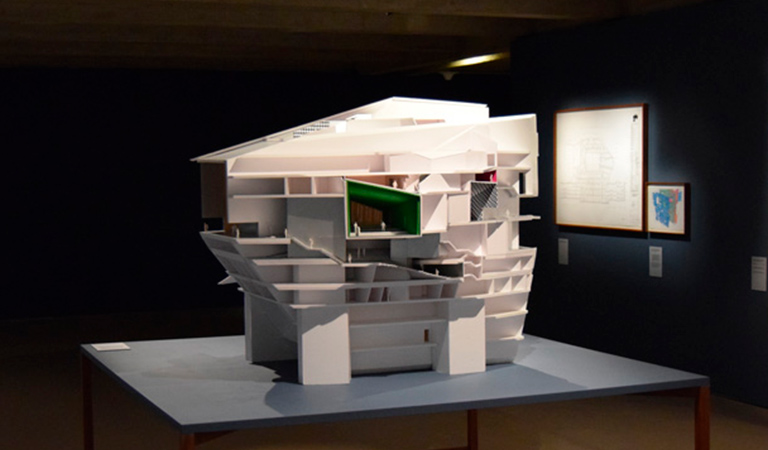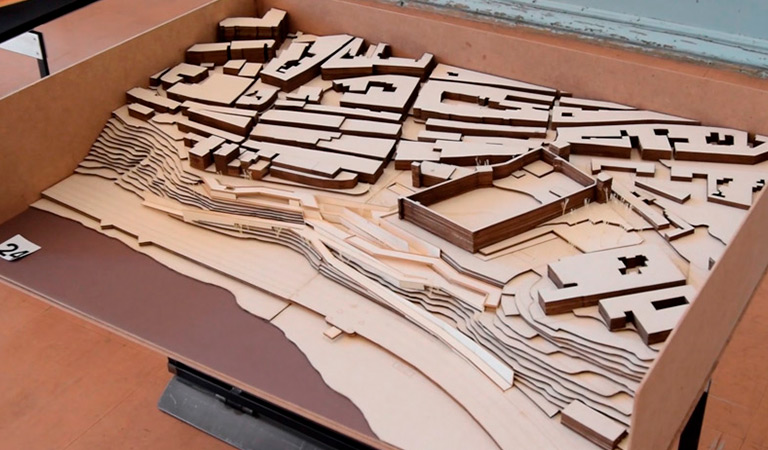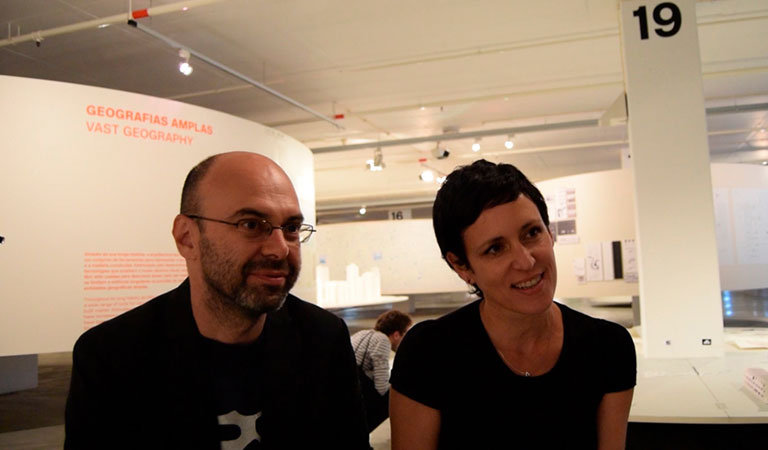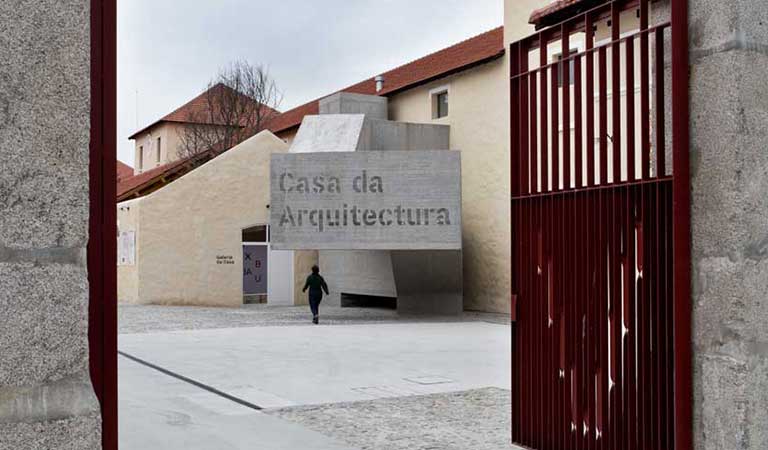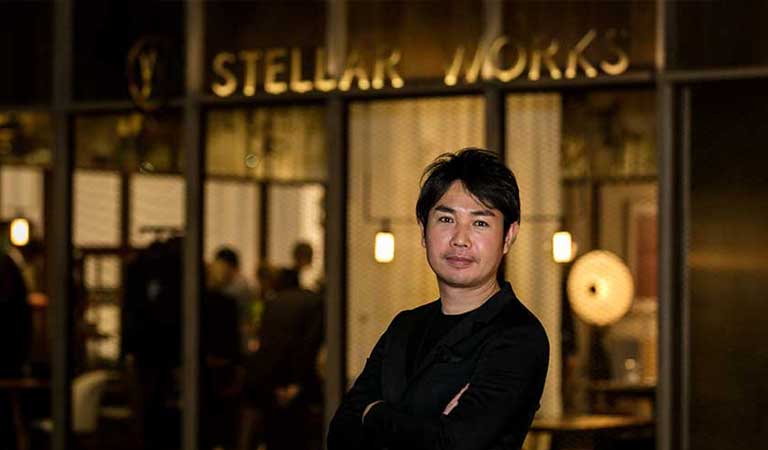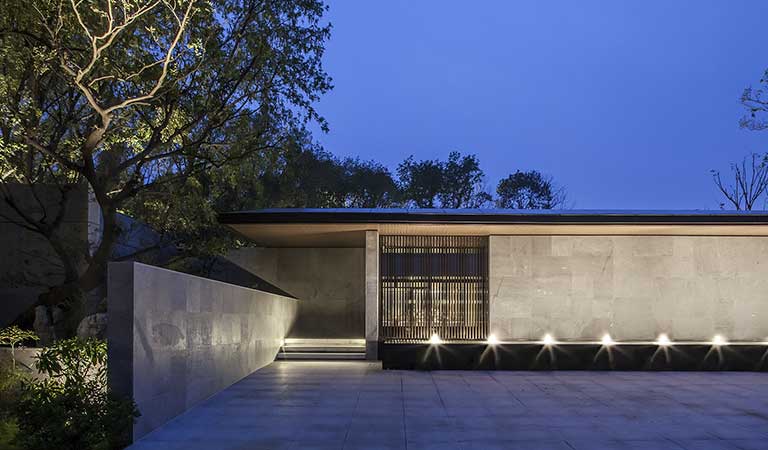As the result of a Summer Studio coordinated by Kirill de Lancastre Jedenov on behalf of The University of Western Australia and the portuguese office Embaixada Arquitectura, “The Thickness of the Limit” set on the patio of the Triennale’s headquarters, is a 1:1 model of one of the projects developed.
We met with the Architects Paulo Albuquerque Goinhas, Cristina Mendonça and Nuno Griff - Embaixada Arquitectura - to find out more about this theme of limit situations in urban environments, and how it materialized in this Summer Studio.
Como resultado de um Summer Studio coordenado por Kirill de Lancastre Jedenov em representação da Universidade Western Australia e pelo gabinete português Embaixada Arquitectura, "A Espessura do Limite", instalada no pátio da sede da Trienal, é uma maquete à escala 1: 1 de um dos projectos desenvolvidos.
Encontrámo-nos com os arquitectos Paulo Albuquerque Goinhas, Cristina Mendonça e Nuno Griff - Embaixada Arquitectura - para saber mais sobre o tema do atelier, situações de limite em ambientes urbanos, e de que forma se materializou neste Summer Studio.
Lisbon Architecture Triennale
— Embaixada Arquitectura —
Cristina Mendonça: This installation, pavilion, which is in the patio of the Triennale is the result of a Summer Studio that we did with the Western Australia University, we competed for the studio, we presented an idea to host the students and the university accepted. Together with the Triennale we organized the partnership we developed over time, and then 21 students came during January and February.
The pavilion is a 1:1 model of one of the projects developed, on a theme that is part of the atelier, which is "the thickness of the limit" and is the title of the Studio. It has to do with dealing with limit situations in urban environments and even in private spaces. It has to do with transitional spaces, how to deal with transitional spaces and how to let the street stop being just a street but also become a public part and public use, so that it isn’t just an austere facade away from the public.
Basically we wanted the program to be quite abstract and leave them quite loose, because normally students are always very attached to a reality, and we wanted them to experience and let go. So we didn’t give them a specific program, we said that they had to develop a private space, more sheltered and more private spaces, and more wide and open spaces for a larger audience, for the permanence of a bigger group of people.
And this experience that’s here - there are a series of models there also of the other groups - this pavilion here is an attempt to create relations of space, public and private, with a density and a work on the line. There are a number of pouches that are being seized along the Triennale courtyard where this relationship of privacies is worked.
Cristina Mendonça: Esta instalação, pavilhão, que está no pátio da Trienal é fruto de um Summer Studio que nós fizemos com a universidade Western Australia, nós concorremos ao studio, apresentámos uma ideia para sermos hosts dos alunos e a universidade aceitou. Nós juntamente com a Trienal organizámos toda a parceria que desenvolvemos ao longo do tempo, e entretanto vieram 21 alunos durante Janeiro e Fevereiro.
O pavilhão é uma maquete 1:1 de um dos projetos desenvolvidos, sobre um tema que é parte do atelier, que é “the thickness of the limit” e é o titulo do studio. Tem a ver com lidar com situações de limite ou seja em ambientes urbanos e mesmo dentro de espaços privados. Tem a ver com espaços de transição, como lidar com espaços de transição e como deixar que a rua deixe de ser só rua e passe a ser também uma parte pública e de uso público, e que não seja fachada austera e afastada do público.
Basicamente quisemos que o programa fosse bastante abstrato e deixá-los bastante soltos, porque normalmente os alunos estão sempre muito agarrados a uma realidade, e nós queríamos que eles experimentassem e se soltassem. Então nós não demos programa especifico, falámos que eles tinham que desenvolver um espaço privado, espaços mais abrigados e mais privados, e espaços mais francos e abertos para um público maior, para uma permanência de um maior número de pessoas.
E esta experiência que está aqui - estão uma série de maquetes ali também dos outros grupos- este pavilhão que está aqui é uma tentativa de criar relações de espaço, público e privado, com uma densidade e com um trabalho sobre a linha. Há uma série de bolsas que se vão apreendendo ao longo do pátio da Trienal em que é trabalhada essa relação de privacidades.
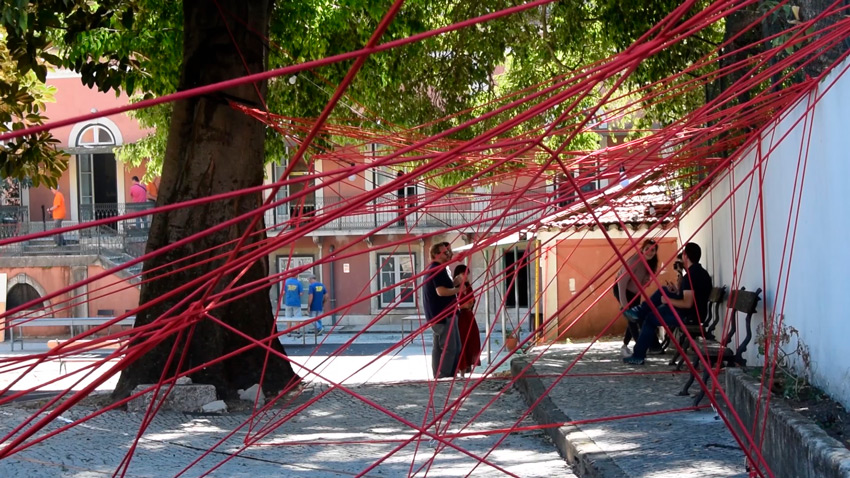
The Thickness of the limit - Lisbon Architecture Triennale HQ
Line the pavilion (1st prize, invited jury) - Julia Kaptein, Charlotte Smail, Charlotte Lane and Katarina Schnell
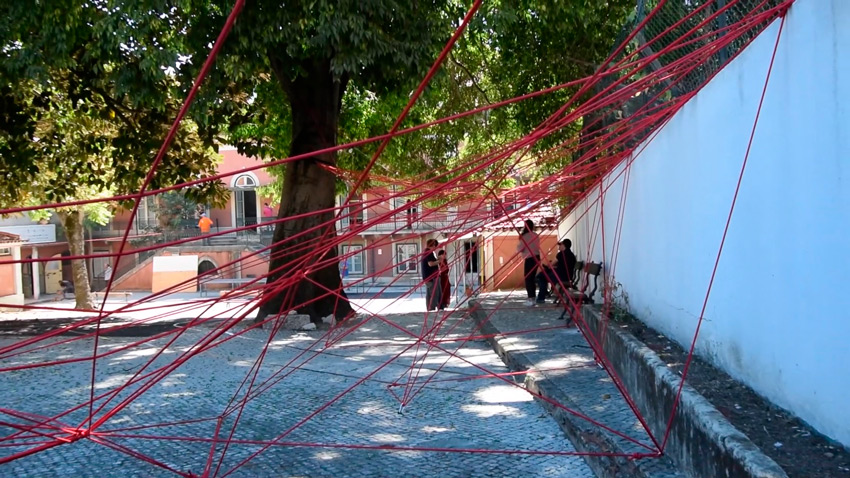
The Thickness of the limit - Lisbon Architecture Triennale HQ
Line the pavilion (1st prize, invited jury) - Julia Kaptein, Charlotte Smail, Charlotte Lane and Katarina Schnell
Paulo Albuquerque Goinhas: On the other side, in the educational sense, what we also wanted to do was a process of "research by design" in which the investigation is done with the act of construction itself. And all the exercises that culminate in this final exercise were made to amplify what was the perception of space from the body, there were a series of exercises especially focused on this, in order to generate an empathy, a memory in who was producing the work.
And as Cristina already said, since we were working with matter, much more abstract concepts, didn’t make sense to have a very concrete program, and we were also not expecting concrete results other than this result that would be a physical experience in the space, a physical experience of the movement of the body in space.
This was relevant and was the goal that was to be achieved, and was still achieved during the end of the exercise because all the students assembled a section of their proposal at 1: 1 scale. So it was possible for us and for the jury to experiment spatially, with a piece of the pavilion of each of the students, and it’s now possible for everyone to experience the whole of one of the pavilions.
Paulo Albuquerque Goinhas: O outro lado, que é do ponto de vista pedagógico, aquilo que também nos interessava era fazer um processo de “research by design” em que a investigação é feita com o próprio acto de construção. E todos os exercícios que culminam neste exercício final foram feitos para ampliar aquilo que era a percepção do espaço a partir do corpo, houve uma série de exercícios especialmente focados nisso, de forma a gerar uma empatia, uma memória em quem estava a produzir o trabalho.
E como a Cristina já disse, como estávamos a trabalhar com matérias, conceitos muito mais abstratos não fazia sentido ter um programa muito concreto, e nós também não estávamos à espera de ter resultados concretos com excepção de esse resultado que iria ser uma experiência física no espaço, uma experiência física do movimento do corpo no espaço.
Isso era relevante e era o objectivo que se pretendia alcançar e que se alcançou ainda durante o final do exercício porque todos os alunos montaram um troço da sua proposta à escala 1:1. Portanto foi possível para nós e para o júri experimentar espacialmente um pedaço do pavilhão de cada um dos alunos, e é possível agora para toda a gente experimentar ou experienciar a totalidade de um dos pavilhões.
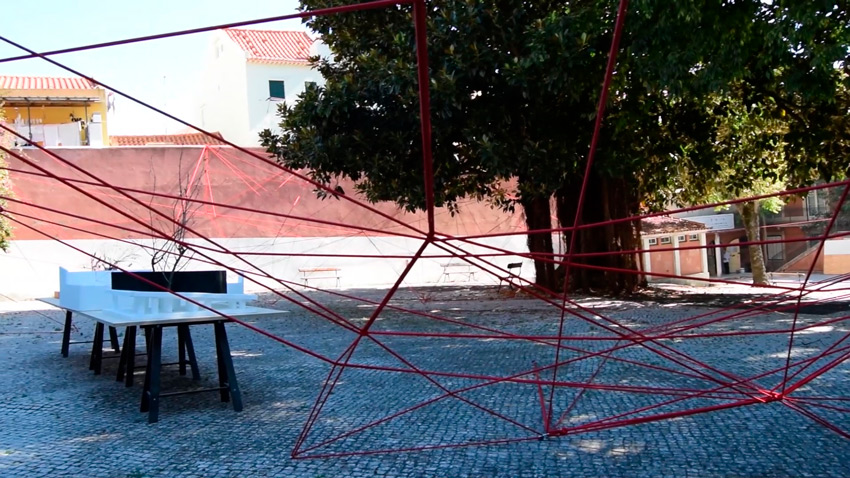
The Thickness of the limit - Lisbon Architecture Triennale HQ
Line the pavilion (1st prize, invited jury) - Julia Kaptein, Charlotte Smail, Charlotte Lane and Katarina Schnell
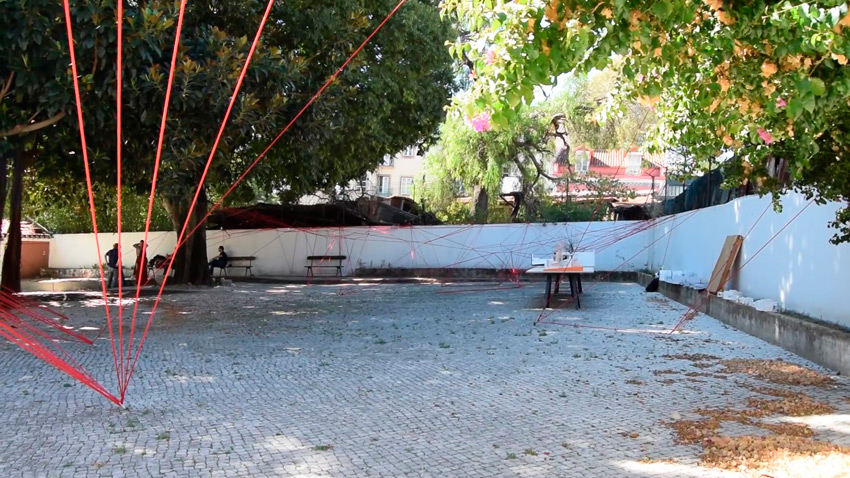
The Thickness of the limit - Lisbon Architecture Triennale HQ
Line the pavilion (1st prize, invited jury) - Julia Kaptein, Charlotte Smail, Charlotte Lane and Katarina Schnell
Cristina Mendonça: They had a month and a half, January to the middle of February here, in the Triennial palace. We stayed on the first floor, so the relationship they always had over all the exercises, and the experimentation at the very spot where they were going to intervene was very close, they spent a lot of time here on the patio.
Cristina Mendonça: Eles tiveram mês e meio, Janeiro a meio de Fevereiro aqui, no palácio da Trienal. Ficámos no primeiro andar, portanto a relação que eles tiveram sempre ao longo de todos os exercícios, e a experimentação no próprio sítio onde eles iam intervir foi muito estreita, eles passaram muito tempo aqui no pátio.
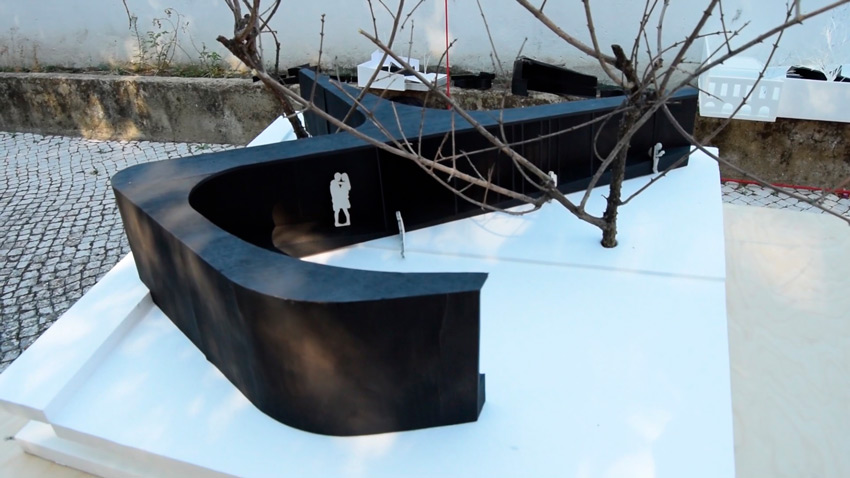
The Thickness of the limit - Lisbon Architecture Triennale HQ
Palacio Preto pavilion (1st prize, official jury) - Craig Nener, Kate Bonner, Kathryn Sims and Alaric Korb.
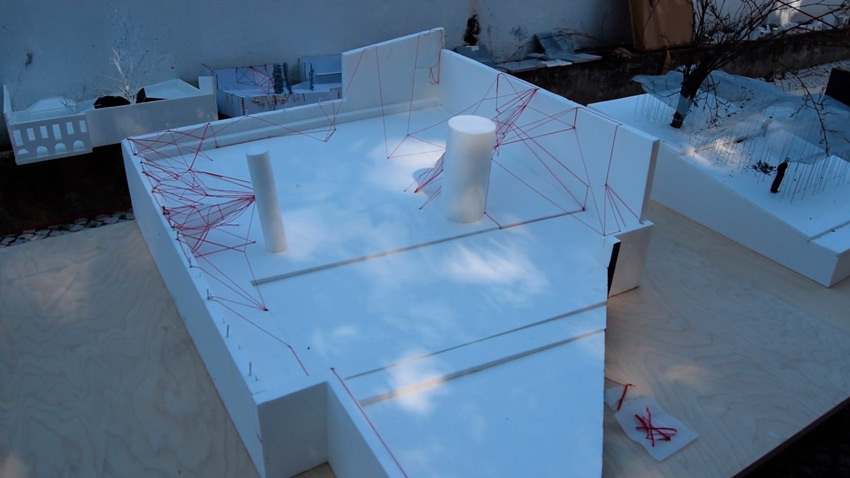
The Thickness of the limit - Lisbon Architecture Triennale HQ
Line the pavilion (1st prize, invited jury) - Julia Kaptein, Charlotte Smail, Charlotte Lane and Katarina Schnell
Paulo Albuquerque Goinhas: We were always between a research that was extremely abstract, abstract and emotional, and very concrete because we were working concepts but working these concepts with our body, with the students body, in the space where this intervention was going to take place. We were in these two extremes, we fled the center and we were at both ends working simultaneously. This was the result.
Nuno Griff: Yes, it was the yard, the garden itself was always the yard of a set of operations.
And I think it may also be important to talk and it was interesting in the process of implementing this proposal, this was a process partly funded by the atelier as the one who organized the studio, and partly by a crowdfunding process made from the students of the studio. What was also very interesting and it was confirmed that they managed it yesterday, it was the last day, to reach the objectives either for part of the funding of the pavilion as well as funding to come to Lisbon to visit their first work.
Paulo Albuquerque Goinhas: Nós tivemos sempre entre uma pesquisa que era extremamente abstrata, abstrata e emocional, e muito concreta porque estávamos a trabalhar conceitos mas a trabalhar esses conceitos com o nosso corpo, com o corpo dos alunos, no espaço onde essa intervenção ia ser. Estávamos nestes dois extremos, fugimos do centro e estávamos nos dois extremos a trabalhar em simultâneo. Este foi o resultado.
Nuno Griff: Sim, foi o estaleiro, o próprio jardim sempre foi o estaleiro de um conjunto de operações.
E acho que também pode ser importante falar e que foi interessante no processo de conseguir implementar esta proposta, foi um processo em parte financiado pelo atelier na condição de quem organizou o studio, e em parte por um processo de crowdfunding feito a partir dos alunos do estúdio. O que foi também bastante interessante e que se verificou que conseguiram ontem, foi o último dia, atingir os objectivos quer para parte do financiamento do pavilhão quer para virem a Lisboa visitar a primeira obra deles, neste caso delas porque são só meninas.
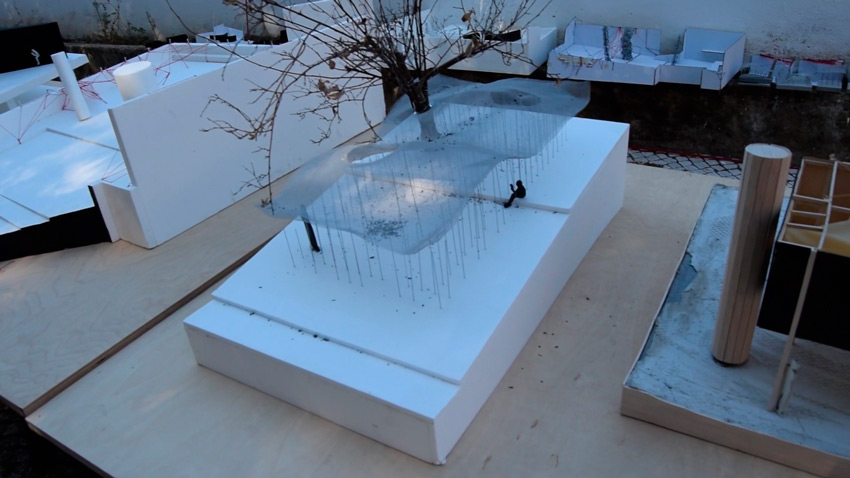
The Thickness of the limit - Lisbon Architecture Triennale HQ
The other canopy pavilion - Nikita Filippou, Benjamin Moffitt, Rachel Tallon, Lesley-Claire Howard and Marian Mahendra
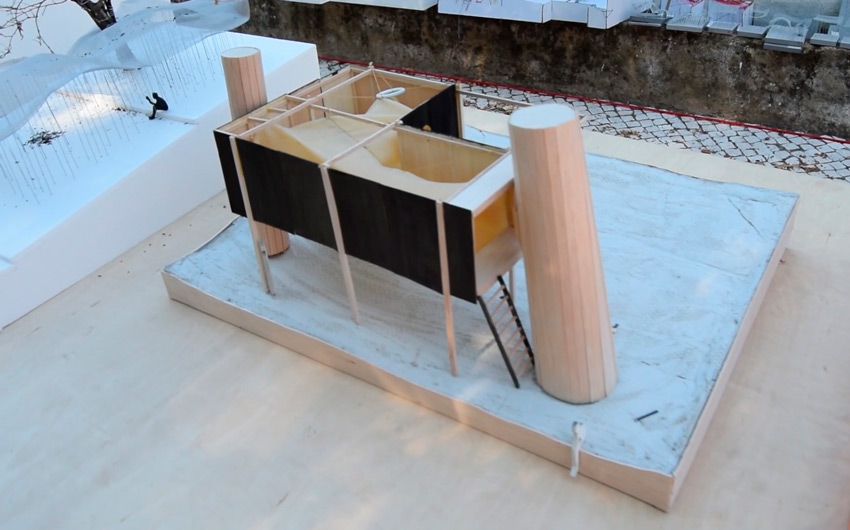
The Thickness of the limit - Lisbon Architecture Triennale HQ
Pink pavilion - Angus Mcbride, Monique Annesley, Sean Heath and Mitchell Hender
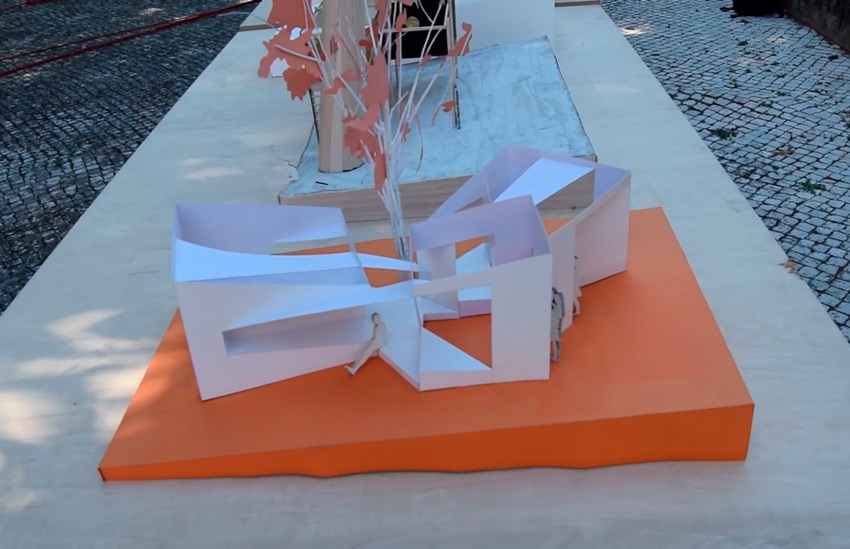
The Thickness of the limit - Lisbon Architecture Triennale HQ
Punctured pavilion - Anna Mustard, Rebecca Hawkett, Jamie Hilton and Beth Litjens
Studio Coordination - University of the Western Australia (Kirill de Lancastre Jedenov) and EMBAIXADA arquitectura (Cristina Mendonça, Nuno Griff and Paulo Albuquerque Goinhas).
Authorship Content - EMBAIXADA arquitectura (Cristina Mendonça, Nuno Griff and Paulo Albuquerque Goinhas)
